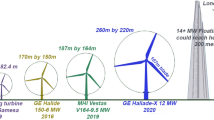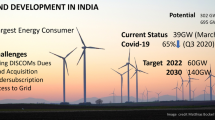Abstract
There is a lack of studies on evaluating the economic feasibility of large-scale wind turbine development in Iran. Thus, this study aims at analyzing the feasibility of large wind turbines installation in Lutak region, situated in the southeast of Iran. For this aim, the 10-min average recorded wind speed data at 40 m height collected from January 2008 to December 2009 in Lutak are analyzed. Based on three reliable statistical indicators, it is found that the Weibull function enjoys excellent capability to analyze the wind data in Lutak. The wind data analysis reveals that the period of May to September is the windiest time of the year for which the wind power classification falls into class 6 or 7. Nevertheless, due to the lower wind potential in the early and late days of year, very high differences are observed between daily mean wind speed as well as wind power values throughout the year. The highest and lowest mean wind speed and wind power occur in July and January. The wind speed lies between 3.85 and 11.26 m/s while the wind power ranges from 78.79 to 1210.32 W/m2. It is also observed that wind blows predominantly from northwest and north directions in Lutak. The performance and economic feasibility of installing four different types of wind turbines with the rated power of 600–900 kW are examined for installation at 40 m height. The attained results indicate that the EWT 52/900 kW wind turbine is a more appropriate economical option.











Similar content being viewed by others
Change history
19 December 2018
The Editors-in-Chief of Environmental Earth Sciences are issuing an editorial expression of concern to alert readers that this article [1] shows substantial indication of irregularities in authorship during the submission process.
References
Abbes M, Belhadj J (2012) Wind resource estimation and wind park design in El-Kef region, Tunisia. Energy 40:348–357
Adaramola MS, Oyewola OM (2011) Evaluating the performance of wind turbines in selected locations in Oyo state, Nigeria. Renew Energy 36:3297–3304
Adaramola MS, Paul SS, Oyedepo SO (2011) Assessment of electricity generation and energy cost of wind energy conversion systems in north-central Nigeria. Energy Convers Manag 52:3363–3368
Akpinar EK, Akpinar S (2005) An assessment on seasonal analysis of wind energy characteristics and wind turbine characteristics. Energy Convers Manag 46:1848–1867
Alamdari P, Nematollahi V, Mirhosseini M (2012) Assessment of wind energy in Iran: a review. Renew Sustain Energy Rev 16:836–8360
Alizadeh-Choobari O, Zawar-Reza P, Sturman A (2014) The “wind of 120 days” and dust storm activity over the Sistan Basin. Atmos Res 143:328–341
Arslan O (2010) Technoeconomic analysis of electricity generation from wind energy in Kutahya, Turkey. Energy 35:120–131
Celik AN (2003) Weibull representative compressed wind speed data for energy and performance calculations of wind energy systems. Energy Convers Manag 44:3057–3072
Dabbaghiyan A, Fazelpour F, Dehghan Abnavi M, Rosen MA (2016) Evaluation of wind energy potential in province of Bushehr, Iran. Renew Sustain Energy Rev 55:455–466
Diaf S, Notton G (2013) Technical and economic analysis of large-scale wind energy conversion systems in Algeria. Renew Sustain Energy Rev 19:37–51
Dinpashoh Y, Mirabbasi R, Jhajharia D, Abianeh HZ, Mostafaeipour A (2014) Effect of short-term and long-term persistence on identification of temporal trends. J Hydrol Eng 19(3):617–625
Durišić Ž, Mikulović J (2012) Assessment of the wind energy resource in the South Banat region, Serbia. Renew Sustain Energy Rev 16:3014–3023
Elamouri M, Amar FB (2008) Wind energy potential in Tunisia. Renew Energy 33:758–768
Elliott DL, Schwartz MN (1993) Wind energy potential in the United States, PNL-SA-23109. Richland, WA: Pacific Northwest Laboratory; September 1993. NTIS no. DE94001667
Fazelpour F, Soltani N, Soltani S, Rosen MA (2015) Assessment of wind energy potential and economics in the north-western Iranian cities of Tabriz and Ardabil. Renew Sustain Energy Rev 45:87–99
Habibi F (2013) Economic evaluation of wind projects in Iran. Industrial Engineering Department. Yazd University, Iran. (in Persian)
http://www.mojnews.com/en/Miscellaneous/ViewContents.aspx?…I. <Accessed Feb 12, 2014>
http://www.wikipedia.com. <Accessed Feb 20, 2014>
http://www.hewind.com. <Accessed Feb 6, 2014>
http://www.ewtdirectwind.com. <Accessed Feb 6, 2014>
http://www.awe-wind.com. <Accessed Feb 6, 2014>
http://www.thewindpower.net/country-datasheet-38-iran.php. <Accessed Jan 20, 2014>
http://www.suna.org.ir/. <Accessed Jan 5, 2014>
Islam MR, Saidur R, Rahim NA (2011) Assessment of wind energy potentiality at Kudat and Labuan, Malaysia using Weibull distribution function. Energy 36:985–992
Jain P (2011) Wind energy engineering. McGraw Hill, USA. ISBN 978-0-07-171478-5
Kazemi Karegar H, Zahedi A, Ohis V, Taleghani G, Khalaji M (2006) Wind and solar energy development in Iran. North Amir Abad, Tehran/Iran: Centre of Renewable Energy Research and Application
Keyhani A, Ghasemi-Varnamkhasti M, Khanali M, Abbaszadeh R (2010) An assessment of wind energy potential as a power generation source in the capital of Iran, Tehran. Energy 35:188–201
Kousari MR, Ahani H, Hakimelahi H (2013) An investigation of near surface wind speed trends in arid and semiarid regions of Iran. Theor Appl Climatol 14:153–168
Liu FJ, Chang TP (2011) Validity analysis of maximum entropy distribution based on different moment constraints for wind energy assessment. Energy 36:1820–1826
Malik A, Al-Badi AH (2009) Economics of Wind turbine as an energy fuel saver-A case study for remote application in Oman. Energy 34:1573–1578
Mathew S (2006) Wind energy: fundamentals, resource analysis and economics. Springer, Berlin
Menges HO, Ertekin C, Sonmete MH (2006) Evaluation of solar radiation models for Konya, Turkey. Energy Convers Manag 47:3149–3173
Mirhosseini M, Sharifi F, Sedaghat A (2011) Assessing the wind energy potential locations in province of Semnan in Iran. Renew Sustain Energy Rev 15:449–459
Mohammadi K, Mostafaeipour A (2013) Economic feasibility of developing wind turbines in Aligoodarz, Iran. Energy Convers Manag 76:645–653
Mostafaeipour A (2010a) Feasibility study of harnessing wind energy for turbine installation in province of Yazd in Iran. Renew Sustain Energy Rev 14:93–111
Mostafaeipour A (2010b) Historical background, productivity and technical issues of qanats. Water Hist 2:61–80
Mostafaeipour A (2011) Productivity and development issues of global wind turbine industry. INTECH Open Access Publisher
Mostafaeipour A (2013) Economic evaluation of small wind turbine utilization in Kerman, Iran. Energy Convers Manag 73:214–225
Mostafaeipour A, Abarghooei H (2008) Harnessing wind energy at Manjil area located in north of Iran. Renew Sustain Energy Rev 12:1758–1766
Mostafaeipour A, Abesi S (2010) Wind Turbine Productivity and Development in Iran. Biosciences (BIOSCIENCESWORLD), International Conference Bari, Italy, pp 112–118
Mostafaeipour A, Sedaghat A, Dehghan-Niri AA, Kalantar V (2011) Wind energy feasibility study for city of Shahrbabak in Iran. Renew Sustain Energy Rev 15:2545–2556
Mostafaeipour A, Sedaghat A, Ghalishooyan M, Dinpashoh Y, Mirhosseini M, Sefid M, Pourrezaei M (2013) Evaluation of wind energy potential as a power generation source for electricity production in Binalood, Iran. Renew Energy 52:222–229
Mostafaeipour A, Jadidi M, Mohammadi K, Sedaghat A (2014) An analysis of wind energy potential and economic evaluation in Zahedan, Iran. Renew Sustain Energy Rev 30:641–650
Nedaei M (2012) Wind resource assessment in Abadan airport in Iran. Int J Renew Energy 1(3):87–97
Pishgar-Komleh SH, Keyhani A, Sefeedpari P (2015) Wind speed and power density analysis based on Waybill and Rayleigh distributions (a case study: Firouzkooh county of Iran). Renew Sustain Energy Rev 42:313–322
Pourrajabian A, Mirzaei M, Ebrahimi R, Wood D (2014) Effect of air density on the performance of a small wind turbine blade: a case study in Iran. J Wind Eng Ind Aerodyn 126:1–10
Pouyan S, Ganji A, Behnia P (2011) Regional analysis of wind climatic erosivity factor: a case study in Fars province, southwest Iran. Theor Appl Climatol 105:553–562
Quan P, Leephakpreeda T (2015) Assessment of wind energy potential for selecting wind turbines: an application to Thailand. Sustain Energy Technol Assess 11:17–26
Roshan G, Najafei MS, Costa AM, Orosa JA (2015) Effects of climate change on wind energy production in Iran. Arab J Geosci 8:2359–2370
Saeidi D, Mirhosseini M, Sedaghat A, Mostafaeipour A (2011) Feasibility study of wind energy potential in two provinces of Iran: North and South Khorasan. Renew Sustain Energy Rev 15:3558–3569
Saeidi D, Sedaghat A, Alamdari P, Alemrajabi AA (2013) Aerodynamic design and economical evaluation of site specific small vertical axis wind turbines. Appl Energy 101:765–775
Satkin M, Noorollahi Y, Abbaspour M, Yousefi H (2014) Multi criteria site selection model for wind-compressed air energy storage power plants in Iran. Renew Sustain Energy Rev 32:579–590
Sedaghat A, Haj Assad ME, Gaith M (2014) Aerodynamics performance of continuously variable speed horizontal axis wind turbine with optimal blades. Energy 77:752–759
Shu ZR, Li QS, Chan PW (2015) Statistical analysis of wind characteristics and wind energy potential in Hong Kong. Energy Convers Manag 101:644–657
Sulaiman MY, Akaak AM, Wahab MA, Zakaria A, Sulaiman ZA, Suradi J (2002) Wind characteristics of Oman. Energy 27:35–46
Yu X, Qu H (2010) Wind power in China: opportunity goes with challenge. Renew Sustain Energy Rev 14:2232–2237
Author information
Authors and Affiliations
Corresponding author
Rights and permissions
About this article
Cite this article
Mohammadi, K., Mostafaeipour, A., Sedaghat, A. et al. Application and economic viability of wind turbine installation in Lutak, Iran. Environ Earth Sci 75, 248 (2016). https://doi.org/10.1007/s12665-015-5054-7
Received:
Accepted:
Published:
DOI: https://doi.org/10.1007/s12665-015-5054-7




